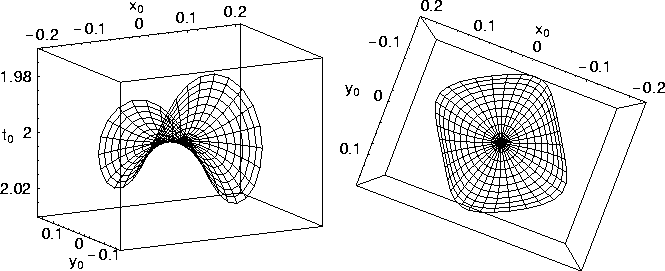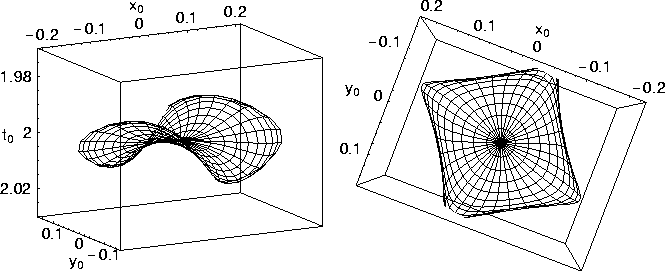 |
Figure 10 A side (left) and a top (right) view of the AMO operator for a VTI vertically inhomogeneous medium for an input and output offset of 2 km and correction to only the azimuth of 30 degrees. The medium has v=1.5+0.6z km/s and
The v(z) modal used here is a linear one with velocity given by v(z)=1.5+0.6z km/s. This model is a good representation of many locations in the subsurface, including the Gulf of Mexico.
 |
Figure 10 shows a side and a top view of the AMO operator that corrects for
an azimuth of 30 degrees. The VTI medium has ![]() =0.1.
The anisotropic AMO operator is clearly a stretched version of the isotropic one, shown in
Figure 2. This operator is very similar to the homogeneous medium one
(Figure 5), which clearly suggests
that the impact of v(z) velocity variation
on the operator is small. It also implies that the homogeneous VTI AMO operator can be used to
successfully correct for data from v(z) VTI media.
=0.1.
The anisotropic AMO operator is clearly a stretched version of the isotropic one, shown in
Figure 2. This operator is very similar to the homogeneous medium one
(Figure 5), which clearly suggests
that the impact of v(z) velocity variation
on the operator is small. It also implies that the homogeneous VTI AMO operator can be used to
successfully correct for data from v(z) VTI media.
 |
The same observations hold for even stronger anisotropy given by ![]() . Figure 11 shows such
an operator where clearly the shape of the operator is different from the isotropic one. Such strong anisotropy changes
the shape of the AMO operator considerably. Also, the operator is very similar to the homogeneous medium one (Figure 9), again
suggesting that the influence of such smooth vertical velocity variation is small on the AMO operator, even
for such a strong anisotropy.
. Figure 11 shows such
an operator where clearly the shape of the operator is different from the isotropic one. Such strong anisotropy changes
the shape of the AMO operator considerably. Also, the operator is very similar to the homogeneous medium one (Figure 9), again
suggesting that the influence of such smooth vertical velocity variation is small on the AMO operator, even
for such a strong anisotropy.
In summary, AMO operators in v(z) media are very similar to their homogeneous media counterparts, granted that the strength of anisotropy is the same. If the anisotropy strength changes between the models the AMO operator shape can change, as well. Anisotropy can cause triplications in the operator even at low angles.